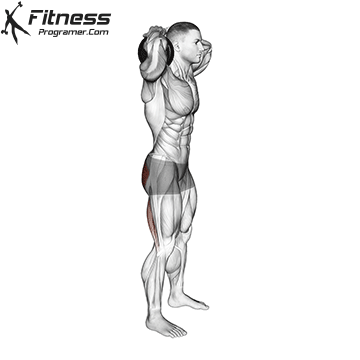Overview
The Dumbbell Good Morning is a strength training exercise that targets the muscles of the lower back, hamstrings, and glutes. It’s an effective compound exercise that helps improve strength, stability, and posture. While you can perform this exercise using a single dumbbell, you also have the option of using alternative weighted objects such as a barbell, kettlebell, or weight plate.
How to do perform Dumbbell Good Morning
-
Hold a dumbbell horizontally across your upper back, not on the neck, gripping each end with both hands.
-
Stand tall with feet hip-width apart, knees slightly bent, and core engaged.
-
Hinge at the hips, pushing your hips back while keeping your spine neutral and chest up.
-
Lower your torso until it’s nearly parallel to the floor or you feel a deep stretch in your hamstrings.
-
Drive your hips forward to return to the starting position, squeezing your glutes at the top.
-
Repeat for the desired number of reps, maintaining control and posture throughout.
Tips for Proper Form
-
Keep a flat back throughout the movement to protect your spine.
-
Engage your core to stabilize the torso and prevent rounding.
-
Use a slight bend in the knees to keep tension in the hamstrings.
-
Move slowly and with control to focus on muscle activation.
-
Start with a light weight to master the hip hinge movement pattern.
Common Mistakes
-
Rounding the lower back, which increases injury risk.
-
Letting the knees lock out, which limits mobility and can cause strain.
-
Tilting the head upward, which disrupts spinal alignment.
-
Holding the dumbbell on the neck, which puts pressure on cervical spine.
-
Bending at the waist instead of the hips, reducing posterior chain activation.
Note: It’s worth noting that weighted Good Mornings can be a challenging exercise, and they may not be suitable for everyone. Weighted Good Mornings can be safe when performed with proper technique, appropriate precautions, and within your fitness level. Always prioritize safety and proper form to minimize the risk of injury. If you’re unsure about your ability to perform this exercise safely, seek guidance from a fitness expert or trainer.
Benefits of the Dumbbell Good Morning
-
Strengthens the posterior chain: Targets the glutes, hamstrings, and lower back, improving strength and power.
-
Improves hip hinge mechanics: Reinforces proper form for deadlifts, swings, and other hinge-based movements.
-
Enhances hamstring flexibility: The deep stretch at the bottom helps lengthen and mobilize the hamstrings.
-
Promotes better posture: Strengthens postural muscles that support spinal alignment.
-
Reduces injury risk: Builds resilience in the lower back and hamstrings, especially for athletes and lifters.
-
Builds glute engagement: Helps isolate and activate glutes at the top of the lift for improved strength and aesthetics.
-
Low equipment requirement: Requires just one dumbbell and minimal space, making it perfect for home workouts.
- Functional Strength: The hip hinge movement pattern used in Dumbbell Good Mornings mimics many real-life movements, such as picking up objects from the ground. Improving strength in this pattern can enhance daily functional abilities.
How to Incorporate Into Your Routine
- For Beginners: Perform 2 to 3 sets of 10 to 12 reps with light weight, focusing on hip hinge form.
- For Hypertrophy: Use moderate weight for 3 to 4 sets of 8 to 10 reps, emphasizing the stretch and glute squeeze.
- For Strength: Perform 4 sets of 6 to 8 reps with a heavier dumbbell, ensuring strict control and posture.
- For Functional Training: Pair with mobility or balance drills to reinforce hip control and spinal awareness.
- For Circuit Training: Use as a posterior chain movement within a bodyweight or light-weight circuit for 30 seconds per round.
- For General Fitness: Include 2 to 3 times per week as part of a balanced leg or posterior chain routine.
- For Mobility and Rehab: Use slow tempo reps and a lightweight dumbbell to improve flexibility and neuromuscular control.
Muscles Worked

Frequently Asked Questions
Is the dumbbell good morning safe for my back?
Yes, when performed with proper hip hinge form and a neutral spine, it strengthens your lower back and protects against injury.
Can I use one dumbbell or two?
One dumbbell held across the upper back is standard, but you can hold one in each hand at your sides for a variation.
Should I go parallel to the floor?
Lower until you feel a deep hamstring stretch while maintaining a flat back. You don’t need to go parallel if flexibility or form is compromised.
Can beginners do this movement?
Absolutely. Start with a very light weight or even bodyweight to master the hinge pattern before progressing.

